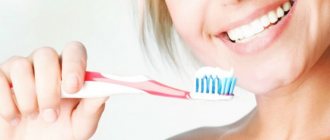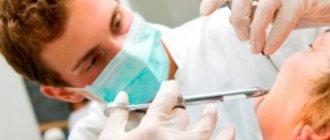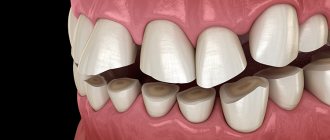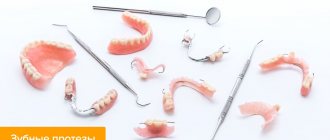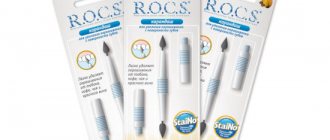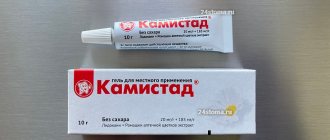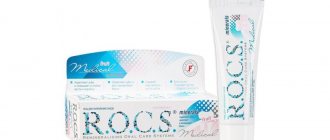What is comprehensive teeth cleaning
Each of us follows basic hygiene rules, including brushing our teeth twice a day. With the help of this simple manipulation, we remove plaque accumulated during the day or night. But the problem is that the interdental spaces and hard-to-reach areas remain uncleaned or not cleaned well enough. As a result, plaque begins to accumulate in these places, and then mineralizes, that is, turns into tartar. It is impossible to remove it with a simple brush and paste. In this case, only professional help from a dentist will help.
The doctor, depending on the type of deposits, may suggest one or another method of cleansing.
The specificity of the instruments used determines the narrow focus of the impact. For example, ultrasonic waves can crush stone, and Air Flow technology can remove soft plaque. Human teeth simultaneously contain both already fossilized and still soft fractions, so for total cleansing it is necessary to use not just one method of professional hygiene, but several procedures in combination. In addition, the enamel layer, having lost its “shell” and has already begun to demineralize underneath, becomes very vulnerable for some time. Therefore, to restore it, it needs recharge, in particular fluorine. Based on the above, we can conclude that only a set of cleaning and protective measures will help your teeth be healthy and beautiful. Comprehensive cleaning includes the following procedures:
- ultrasonic treatment;
- cleansing using Air Flow technology;
- polishing the enamel layer;
- fluoridation.
Make an appointment with a doctor (Shchelkovo dentistry “Sanident”). Solving hygiene problems
Before you go to the dentist for an appointment, it is better to make an appointment in advance. This action is guaranteed to ensure a visit to the doctor and will significantly save personal time.
Teeth cleaning in the clinic occurs in several stages:
- Carrying out mechanical or chemical cleaning. This procedure is aimed at removing dental plaque, including stones.
- Carrying out grinding. The manipulation is carried out using special brushes, a mechanical tip, and a special prophylactic paste.
- Carrying out tooth polishing. It is carried out similarly to polishing fillings. The procedure prevents the accumulation of plaque.
- Application of special substances containing fluorine. The procedure strengthens tooth enamel and saturates the tooth with minerals.
Making an appointment with a doctor, Shchelkovo dentistry (Sanident clinic) will allow you to plan your visit to the doctor at the most convenient time for you.
Professional oral hygiene is an absolutely harmless procedure for teeth and gums, which helps in the fight against the occurrence of dental diseases by preventing their occurrence. Also, your smile will become dazzling and whiter after a visit to the dental office, because the presence of plaque, which specialists can easily remove, significantly worsens the color of the teeth, making them yellow.
When is a procedural complex necessary and when it cannot be performed?
Indications for comprehensive cleaning:
- Prevention of caries and periodontal diseases
- Strengthening the enamel layer
- Improving smile aesthetics
- Removing tartar and soft deposits
- Eliminating bad breath
- Before dentures, implantation, installation of braces
- While wearing braces and after removing them
- For crowded teeth
Contraindications:
- Childhood
- Severe cardiovascular diseases
- Presence of a pacemaker
- Difficulty in nasal breathing
- Any disease in the acute period
- Allergy to components of medications used
Assistive methods for brushing with a toothbrush
Fones method
It belongs to the American dentist Alfred Fones, who is considered one of the founders of hygienic dentistry. The method is suitable for adults, children and people who do not have periodontal disease.
- To clean the external surfaces, the teeth are closed and the bristles of the brush are placed perpendicular to the surface. The brush head makes circles while simultaneously capturing the teeth of both jaws and the adjacent gums.
- The same movements are performed to clean the internal surfaces (separately for the upper and lower jaws).
- Chewing surfaces are also cleaned using circular movements.
Pros:
good gum massage.
Bass method
The method involves cleaning and massaging the gums with vibrating movements, and cleaning the chewing surfaces with horizontal movements. Advantages:
The method is suitable for cleaning teeth with exposed roots. You can only use a soft brush.
The first stage is ultrasonic treatment
Ultrasound of a certain frequency is capable of coloring tartar into small fragments. Therefore, it is used to remove mineralized deposits on the enamel layer in the supragingival and subgingival zone. This procedure is the first item on a comprehensive list. An ultrasonic scaler destroys stone and, along with it, removes pathogenic microflora in the most inaccessible places of the dentition. Ultrasound is absolutely safe for human health in general and gums in particular. The scaler has an attachment that focuses ultrasound radiation on the area that needs to be treated. The device allows manual adjustment of the intensity of exposure. It is determined by the dentist depending on the conditions of a particular clinical case.
Important: a bonus of using ultrasound is its ability to destroy pathogenic bacteria, i.e., to disinfect the surface being treated. Therefore, dentists strongly recommend performing this procedure for patients with periodontal health problems, not only during a course of treatment, but also regularly to prevent inflammation.
Second stage – Air Flow
After removing hard contaminants, it is time for deposits with a soft structure. Cleansing is performed using Air Flow technology. Using a special apparatus, a mixture of water, air and tiny grains of soda is applied to the surface of the patient’s teeth. The abrasive size is so small that it can destroy the bacterial film, but cannot leave scratches on the enamel surface. A stream of abrasive mixture directed under pressure destroys pigmented plaque and immediately washes it away. Thanks to this, the enamel is lightened to its natural tone (by about 1 - 2 shades on the Vita scale).
Note: the process is painless, but may cause slight discomfort for people with hypersensitive enamel. In this case, the doctor may suggest local anesthesia. Patients who are allergic to soda should not perform this cleaning.
Third stage - polishing
Deposits leave microcracks and irregularities on the enamel layer. Therefore, polishing is necessary after cleaning procedures. Otherwise, the remaining roughness will become a “magnet” for microparticles of food, which will very quickly turn into new deposits. Polishing is performed using abrasive pastes and various attachments driven by a drill. These are polishers, brushes, discs, needle-shaped attachments. The interdental areas are polished with special strips. The process does not cause pain and takes about 40 minutes.
Mistakes when brushing teeth and their consequences
Main mistakes and their consequences:
- Infrequent or insufficiently long brushing can lead to the formation and accumulation of a large amount of plaque. Over time, inflammatory processes will begin to occur in the oral cavity, leading to the destruction of enamel and causing caries.
- Brushing too often can not only damage and thin the enamel, but also lead to bleeding gums.
- Horizontal rather than vertical cleaning techniques eventually lead to the destruction of the upper layers of enamel. However, using an exclusively vertical technique can result in plaque being concentrated in the interdental space.
- If you do not use dental floss, food debris will accumulate in the interdental space, which, together with harmful bacteria, will lead to the process of decay and, as a result, the formation of caries.
- If you do not wash and dry the brush after use, plaque particles and bacteria will remain on it. During the next brushing, microorganisms will again enter the oral cavity.
- Rinse your teeth with tap water. Running water contains many impurities that negatively affect the condition of the enamel and can neutralize the beneficial effects of the toothpaste components on the teeth.
The fourth stage - fluoridation
As a rule, fluoridation is not included in the calculation of comprehensive professional hygiene, but it is very important for dental health. The application of fluoride helps strengthen the enamel layer (prevents the leaching of calcium), reduces hypersensitivity, prevents the onset of caries (slows down the proliferation of pathogenic bacteria). Therefore, you should not refuse this procedure. Fluoridation algorithm: the doctor dries the surface to be treated with a warm air stream, then applies fluoride varnish (a harmless composition based on varnish with a high concentration of fluorides) to each element of the dentition, then dries it.
Note: after completing all stages of comprehensive cleansing, teeth become noticeably lighter, reaching their natural natural color. But those patients who dream of a snow-white smile can resort to whitening, for example, using the ZOOM-4 method.
Dentists' tips for caring for your teeth after a comprehensive cleaning
It is in the patient’s interests that the effect of the complex of procedures lasts as long as possible. Therefore, it is important to follow the following recommendations from your dentist in the first few days:
- do not eat or drink for 2 hours after visiting the dentist;
- You should brush your teeth for 3–5 minutes after each meal and at night;
- possible increase in enamel sensitivity. Do not consume food or drinks that are too hot or too cold;
- try not to smoke, tobacco tars eat into the enamel very quickly;
- Reduce (or eliminate) from your diet foods and drinks that contain high amounts of natural and artificial coloring substances.
The dental network offers comprehensive teeth cleaning services. Our clinic offers family and savings discounts. Doctors are highly qualified and improve their skills in leading dental clinics in Russia and Europe. The level of services provided meets international standards.
Branches of our orthodontic center are located in Moscow within walking distance from the metro:
- Art. Alekseevskaya (VDNKh district, etc. Mira), address: st. 3rd Mytishchiskaya house 3, building 2;
- Art. Shelepikha, address: Shelepikhinskaya embankment, address: building 34, building 1.
We will make your teeth strong, beautiful and healthy! Come and see for yourself.
How to brush your teeth properly video
Video about how to properly brush your teeth. If you do not take care of your oral cavity, you can develop serious dental diseases. Proper hygiene and preventive dental examinations will keep your teeth healthy for life.
0:00 → Not only children, but also adults do not always know how to brush their teeth correctly. Let's now try to understand this issue.
Hello! In this video you will learn how to properly brush your teeth and keep them healthy for life. Please watch this video to the end to get a reminder on how to use a tongue scraper, dental floss, irrigator, and mouth rinse. Let's divide our teeth into segments. The first segment is your right posterior teeth, leading to the central incisor. Next comes the second segment - these are the left chewing teeth. And so clockwise down to the left lower chewing teeth, and then we close it all with the right chewing teeth.
1:06 → If some piece of food gets between the gum and the tooth, we can easily pick it up with the bristles and pull it out. We clean the chewing surface of the teeth with horizontal movements back and forth. It is necessary to make 10-15 such movements. We can complete the cleaning by closing the teeth tightly and brushing them in a circular motion 10-15 times. The next rule: you need to brush your teeth for at least 3 minutes, and even better, a little more, bringing the brushing to 5 minutes. It is also important to brush not only your teeth, but also your tongue and cheeks. This is due to the fact that a large amount of bacterial plaque accumulates on the mucous membrane of the cheeks and tongue, and if it is not cleaned off, this plaque will very quickly spread to your teeth.
2:32 → Therefore, please come to the doctor and tell us in a timely manner about any problems with your gums or bleeding, so that the doctor can find the cause of all this and eliminate it. Now let's note how not to brush your teeth. Under no circumstances should you clean them with horizontal movements, thereby clogging plaque and food debris into the interdental spaces. It will then be extremely difficult to remove plaque from these spaces, and this can lead to caries. And please don't press too hard on the brush. The quality of teeth cleaning does not depend on the force of pressure on the brush, so please do not press the brush too hard on your teeth.
3:28 → After eating, if you don't have the opportunity to brush your teeth, you can always use mouthwash or chewing sugar-free gum. If you have dental implants installed or wear any orthodontic construction, your doctor will always advise you to use an irrigator. It is also necessary to remember that, even using an ultrasonic brush and all the methods that we have just talked about, it is impossible to clean your teeth 100% at home, so I recommend regularly, once every six months, to have your teeth professionally cleaned by a dentist. By following all these simple rules, you can keep your teeth healthy for life. NovaDent specialists have accumulated extensive experience in teaching children and adults proper oral hygiene. Therefore, if you do not want to visit the dentist often for serious reasons, come and we will teach you how to keep your teeth healthy.
